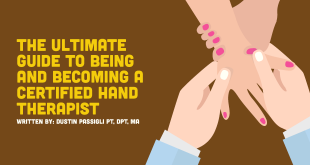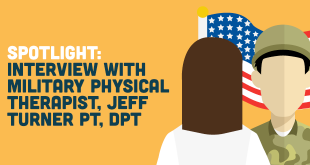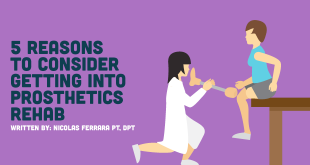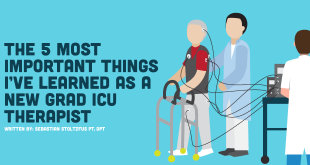Is becoming a sports certified specialist (SCS) worth it?
“That’s too much money and too much time, why would you want to specialize?” Physical therapy specialty certification is a voluntary process that is designed to identify those who are experts within their branch of PT, and willing to endure the extra training.
Specialization is absolutely worth it.
- It opens great opportunities for career advancement
- Specialization increases clinical skills
- It gains you recognition amongst your peers.
The Sports Certified Specialist (SCS) certification allows you to work with your local sports teams, be the primary medical provider at sporting events, and work with the high-level professional athletes that we all love to treat.
When asked if sitting for the SCS exam was worth it, I always respond without hesitation “Absolutely, totally worth it.” It was hands down the hardest, most rewarding, and frightening test of my life. It’s a 6-hour back aching, brain busting, mind-numbing, choose-the-most-correct-answer test. It’s a huge commitment both timewise and financially. Realistically, preparing for the SCS test is 4-6 month process for most people. Despite the rigorous requirements, I feel strongly that if I was offered the chance, I’d do it all over again.
I signed up for the March 2016 SCS test, started studying 18 weeks prior using an Evidence in Motion review course, and received my results in June of 2016.
What, exactly, does sports certified specialist mean?
The SCS is a board certification administered through the American Board of Physical Therapy Specialties (ABPTS). It designates an expert in athletic injury management, including acute care, treatment, rehabilitation, prevention, and education. If you are a physical therapist and think that you are ready to provide sideline coverage I suggest reading this article first.
As quoted from the ABPTS website, “The specialist certification program has been designed to identify and define physical therapy specialty areas and to formally recognize physical therapists who have attained advanced knowledge and skills in those areas. Certification also assists the public and health care community in identifying therapists with acknowledged expertise in a particular field of practice and demonstrates that physical therapists are devoted to addressing the unique needs of the people with whom we work.”
In 1975, the APTA House of Delegates approved the concept of specialization and added board certification in the area of sports in 1981. The first sports specialist certification examination was administered in 1987. Of the certified 1,914 sports specialists currently in practice, 21% completed a residency prior to certification, work primarily in private practice orthopedics, and practiced physical therapy 6-15 years before specializing.
Pros of becoming a sports certified specialist
Work with athletes
One of the most common reasons we pursue a career as a physical therapist is an interest in sports. Most of us participated in sports growing up and likely had first-hand experience with physical therapy, likely sparking our future career interest. The SCS creates opportunities to work with higher level athletes. As an SCS, you will see more motivated, hardworking, HEP compliant patients trying to return to the field. If you are providing care on the sideline, there is a good chance that those same athletes will come to you in the clinic when seeking care. Plus, you’ll have a much better chance at landing a job at an elite sports PT clinic if you have your SCS.
Improve clinical skills
When I graduated from PT school, I was under the impression that my knowledge base would be greater than it was. I’m not criticizing my school – my expectations just weren’t realistic. I was expecting to graduate and immediately be an expert in orthopedic and sports injuries, but as most of us have found out, that was far from the truth.
There is exponentially more information to be learned after PT school. I understand that during school we are taught safety and we are given the foundational skills to later expand upon in any area we choose. In obtaining the SCS certification, I was finally able to scratch that itch I had been trying to scratch with sports-focused therapy. After the test, my confidence in evaluations greatly improved and each part of my treatment now has direct purpose and understanding.
Recognition among other physical therapists
Who doesn’t love some alphabet soup behind their name? Not all certifications and abbreviations hold clout, but the SCS certainly does. You get recognized as an expert in the profession and become the go to person for guidance within the clinic. Patients love to tell their friends they are being treated by “The Sports Specialist” in town and employers love to market your skills.
Potential pay raise
I wish there was an automatic pay raise across the country when achieving a certification and I’ll cross my fingers that one day there will be. Some hospitals offer a 1-3% pay raise with passing a certification exam, which can offset the cost of taking the exam. Extra money on the paycheck always helps, especially in a profession that is truly underpaid compared to our value and level of education. Some places won’t give you any raise, especially in private practice. I will admit that some of my previous employers didn’t know what the SCS was or why I was pursuing it.
Career advancement
Looking for career advancement? Tired of your long hours and difficult patients? The SCS can help with that. Physical therapy is notorious for lateral movement within our profession. It’s easy to move laterally from one job to another, but there are fewer opportunities to move up, unless you own your own clinic, become a professor, or become clinic director. The SCS moves you to the front of the line for that next promotion or to the top of the resume pile when applying for that dream job.
APTA membership
Yes, you “get” to be an APTA member. Some might want to put this in the con category because of the $500 price tag, but it’s unquestionably a positive. The money goes to a good cause in helping progress our autonomy and advocating for our professional development. APTA membership also gives you discounts to journals (JOSPT) and CEU’s.
Cons of becoming a sports certified specialist
Cost
The two main negatives of the testing process is the time requirement and the cost to sit for the exam. The cost can vary a bit depending on if you are an APTA member or not, but it would be a bit silly not to become a member based on the financial savings.
Application fees:
- APTA Member: $515
- Non-APTA Member: $860
- Member/Non-APTA Member Reapplication Fee: $160
- Cost of a review course: $495
Examination fees:
- APTA Member: $800
- Non-APTA Member: $1,525
Maintenance Of Specialist Certification (MOSC) fees:
- APTA Member: $660 paid in 3 equal installments of $220 during each 3-year MOSC cycle
- Non-member: $1,140 paid in 3 equal installments of $380 during each 3-year MOSC cycle
- Plus a nominal, at cost, final exam fee in year 10
Time commitment
The second negative and the hardest part for me personally was the time commitment. There might be a select group of PTs out there who work with professional sports teams and may not need the extra time to study, but they would be in the minority.
To be honest, the time requirement was greater than I had anticipated. I started 4.5 months prior to the test, reviewing and studying with the guidance of the prep course through Evidence in Motion (EIM). This included studying and reading articles during my lunch break and studying after work. Preparing for the SCS took up most of my time on the weekends too, all while putting in a full 40 hours at the clinic. And trust me, I love my weekends – this was a sacrifice for me and my mountain bike.
Plan on dedicating 10-20 hours a week to studying. I chose the EIM course due to the >95% pass rate. I strongly suggest setting a weekly schedule for consistency and to stay on track. For example, reading a research article each day Monday – Thursday. Reading the summaries of each article and reviewing concept reviews for each body part on Friday. I watched the included videos and read the Athletic Training Position statements on Saturdays. Then finally I would take the chapter quiz on Sundays and review the results later that evening.
Lack of public knowledge
One of the most surprising and biggest disappointments in my SCS journey is that most Doctors, DOs, and Orthopedic surgeons don’t know – and, honestly, don’t care – about the specialization. They only care if you can make their patients better. I’ve had to educate the doctors within my area on what the SCS is and how it can help their patients receive better quality care.
This is challenging for me as I’m not one that likes to boast or self-promote, but I have gotten better at it. I’ve had to educate the general public as well so that they can understand what differentiates the SCS from other certifications. The lack of understanding is most apparent when I hear “Oh yeah my personal trainer has his CSCS too.” Total frustration, right?
Preparing for the SCS exam
There are a couple of different paths to obtaining the SCS, with pros and cons for both. The first path is through a physical therapy sports medicine residency. This is a great opportunity for one on one mentorship. It’s nice to study for the exam and be able to apply the knowledge the very next day in a clinical setting.
This route just wasn’t for me. A major con of residency is the salary cut. This can be tough when you just graduated from school and are hoping to attack those gigantic student loans. You can defer your loans one more year, but your loans gain interest in that time period. Residencies are also limited to a few places across the country, although more and more are popping up. I suggest researching them before committing. This means that you are likely going to have to relocate, although EIM does offer a hybrid residency that you may not have to relocate for.
Some of you might chose to go the non-residency route. This has a few advantages over the residency route, including working at a normal salary, being able to live anywhere you want, and allows for learning at your own pace. In talking with other PTs, some studied for an entire year, for few hours a week. Others took the month off prior to the exam and crammed as much information as they could in that one month’s time. In addition, it may take 2 years or longer to get the required 2,000 direct treatment hours, as opposed to doing a residency which accumulates 2,000 hours quickly.
One step that I highly recommend is to take a review course. This will help guide the information and also assist with time management and studying leading up to the exam. For example, there were questions on imaging interpretations, female triad, and topics regarding special populations that I would not have done enough studying for on my own.
Sitting for the test
The exam can only be taken during a 2-week time period in March of each year. It also must be taken at a Prometric Testing Center, which we should all be familiar with after taking our board exams.
The exam is 200 multiple choice questions and you must choose the most correct answer. Like most MC exams, you can usually throw out one or two answers, but there are usually 1-2 answers that could both be right. You have to narrow down the BEST answer. You can flag a question and come back to it later, but once you complete a section you can’t return to it. Also, there is no penalty for guessing, so always put an answer down. The passing score is usually around 60%, which allows for a few missed questions.
- Rehab/Return to Activity: Examination, evaluation, diagnosis (20%)
- Rehab/Return to Activity: Prognosis, intervention, outcomes (20%)
- Acute Injury/Illness Management (15%)
- Medical/Surgical Conditions (15%)
- Injury Prevention (15%)
- Sports Performance Enhancement (10%)
- Professional Roles and Responsibilities (5%)
Very similar to the board exams, the ABPTS has practice or “test” questions for future exams, but you do not know which ones they are. Therefore, if you have absolutely no clue on a question, guess and move on. It might be a practice question and not counted towards your final score.
Most of the questions are case studies or patient examples, but there are a few straight up memory regurgitations like specific nerve root innervations. As a heads up, some of the case studies can be unrealistic. I can’t give examples by law, but case examples might have patients performing activities they wouldn’t dream of in the acute phase of injury. Again, don’t beat yourself up trying to reason the time frame. Choose the best answer using your clinical judgment and move on.
After the exam
Congratulations! You have just taken the hardest test you may ever take. Make sure you go and celebrate with friends and family, grab a cold beverage of choice, then hurry up and wait. The governing board will meet in the coming months to review the questions, throw out questions, and score each exam. The scores are then released on June 15th on a pass/fail basis.
I remember seeing the email in my inbox between patients at work. I was so nervous to open the email in the middle of the day, for fear that I had failed the exam. Having to treat the afternoon patients in a panicked depression was not something I wanted to do. I decided to sneak off and opened the email anyway. Hallelujah! The amount of relief and excitement I felt was indescribable. I was bouncing off the walls for the rest of day.
SCS recertification
The SCS specialist certification lasts for 10-year cycles. During each of those 10-year cycles there are multiple requirements that need to be met to maintain the SCS.
Fees
- APTA Members: $660 paid in 3 equal installments of $220 during each 3-year MOSC cycle
- Nonmembers: $1,140 paid in 3 equal installments of $380 during each 3-year MOSC cycle
Professional standing and direct patient care hours
- In years 3, 6, and 9 must submit evidence of licensure
- In years 3, 6, and 9 must submit evidence of 200 hours of direct patient care
Commitment to lifelong learning
Ongoing professional development within a sports specialty area is tracked online and is best entered at the time of each event. There is not an hour requirement, but you must accrue 30 MOSC credits within each of the 3 activity categories including con-ed coursework, publications, presentations, clinical supervision, research, and teaching.
Practice performance through examples of clinical care and reasoning
Using the same online tracking system, each specialist must submit 1 reflective portfolio in years 3, 6, and 9. These portfolios are not scored. They are reviewed and screened for quality of reflection.
Cognitive expertise through testing
During year 10, you must sit for a shorter recertification of 100 questions. This is similar in content to the original certification exam. If you fail the first attempt, you are allowed one additional attempt and you will maintain the SCS credential during that year period
Emergency Medical Responder (EMR) certification
Must be updated every 2 years similar to CPR certification. The only difference is that the EMR is only offered in select locations across the country. Check out more information about the EMR certification here.
On field hours
Evidence of 10 hours per year of on-field sports venue coverage, or 30 hours in years 3, 6, and 9. This is also tracked using the online system.
Simple steps to the SCS
Now that you are interested and ready to sign up for the SCS, here is a brief overview of the steps and requirements you must fulfill in order to sign up. Happy testing!
The application deadline is July 31st of each year and all minimum requirements must be met at that time of application with the exception of the EMR course. The board application review process takes 6 weeks and approval notification occurs via email.
Minimum requirements
- Must be licensed as a physical therapist
- CPR Certification through American Health Association or American Red Cross
- Emergency Care Certification
- EMT
- First Responder through SPTS (if not completed by July 31st, then you must indicate when you will complete the certification)
- Or ATC within last 10 years
Hour requirements
- 2,00 hours of direct patient care within specialty area within the last 10 years, 500 hours must have occurred within past 3 years
- Or completion of APTA accredited residency within the last 10 years
- Venue coverage (new as of 2017) – required on field management of 100 hours
There you go. That’s everything and more than you could ever want to know about the SCS certification. Congratulations on taking the next step in progressing not only your career but also the profession of physical therapy.
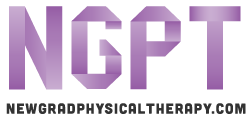 NewGradPhysicalTherapy.com The Largest Online Resource For New Grad Physical Therapists
NewGradPhysicalTherapy.com The Largest Online Resource For New Grad Physical Therapists


